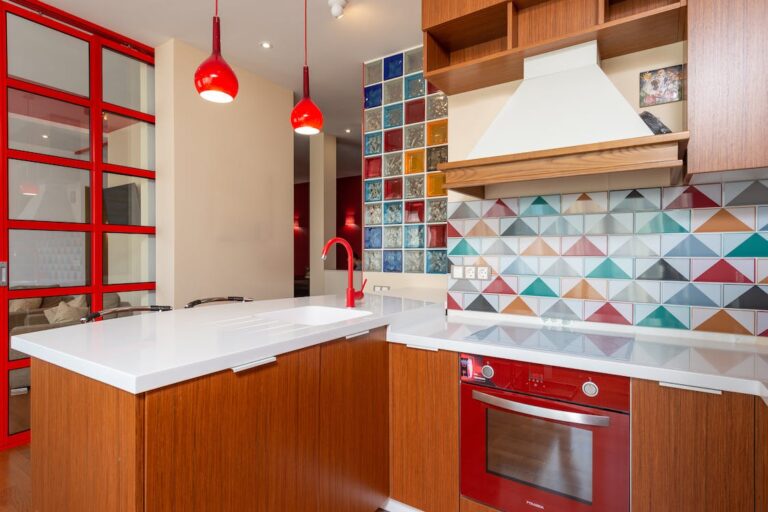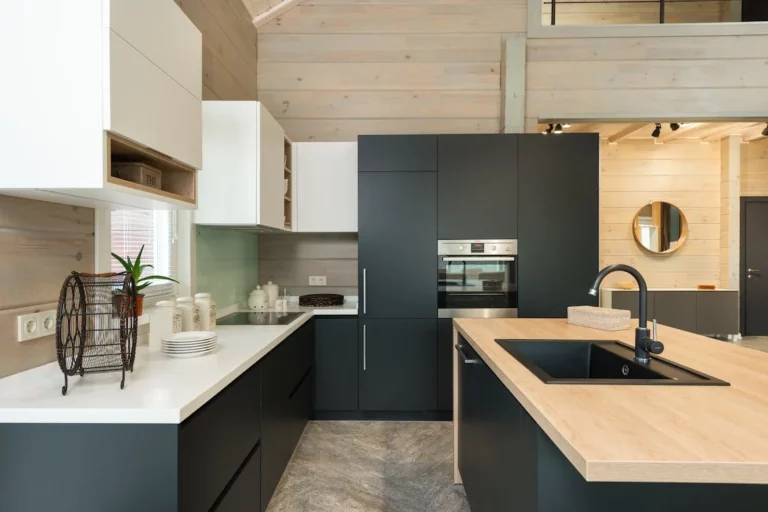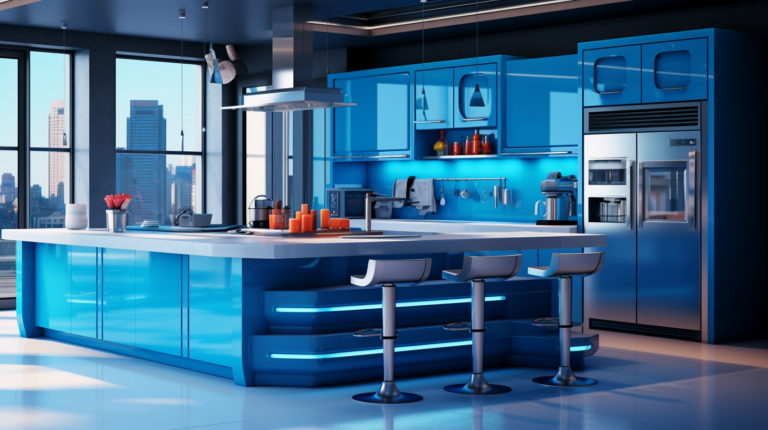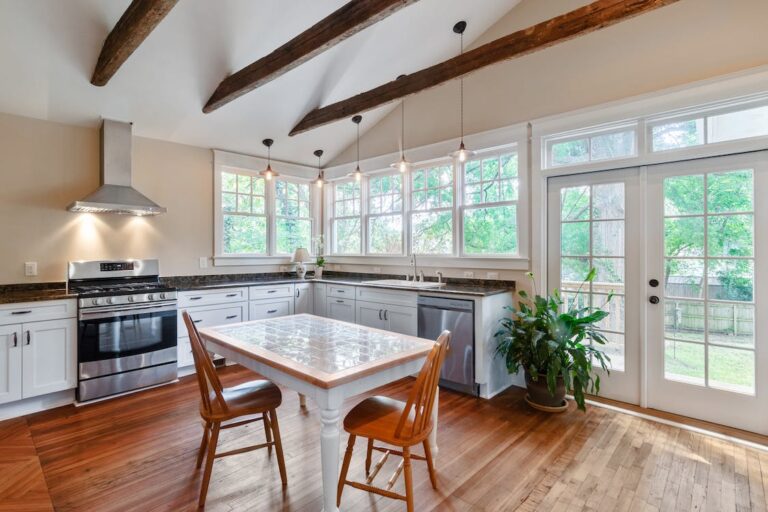The Ultimate Guide to Kitchen Renovations : Best Tips and Ideas in 2023
Are you tired of your outdated and inefficient kitchen? Are you dreaming of a space that is not only functional but also beautiful and inviting? Well, you’re in luck! In this ultimate guide to kitchen renovations, we will provide you with tips and ideas to help you transform your kitchen into the space of your dreams.
Table of Contents
- 0.1 The Ultimate Guide to Kitchen Renovations
- 0.2 Assessing Your Needs and Setting Your Budget
- 0.3 Hiring the Right Professionals
- 0.4 Designing Your Dream Kitchen
- 0.5 Maximizing Storage and Organization
- 0.6 Selecting Appliances and Technology
- 0.7 Lighting and Ventilation
- 0.8 Adding Style and Personality
- 0.9 Ensuring Safety and Functionality
- 0.10 Completing the Renovation Process
- 1 Conclusion
The Ultimate Guide to Kitchen Renovations

Renovating a kitchen can be an exciting yet daunting task. It requires careful planning, budgeting, and decision-making. But with the right guidance and expert advice, you can turn your vision into reality and create a kitchen that you’ll love for years to come.
Whether you’re looking to make small updates or undertake a complete overhaul, this guide will walk you through every step of the process. From assessing your needs and setting your budget to hiring the right professionals and selecting the perfect design elements, we’ve got you covered.
So, grab a cup of coffee, sit back, and let’s dive into the wonderful world of kitchen renovations! Together, we’ll explore the possibilities and unleash the full potential of your kitchen space. Let’s get started!
Assessing Your Needs and Setting Your Budget

When it comes to kitchen renovations, one of the first things you need to do is assess your needs and set a realistic budget. This step is crucial in ensuring that your renovation project is successful and within your financial means. In this section, we will discuss how to determine your renovation goals, evaluate your current kitchen, and set a budget that works for you.
Determining Your Renovation Goals
Before diving into the kitchen renovation process, take some time to think about what you hope to achieve with your new kitchen. Are you looking to create more counter space? Do you want to incorporate a kitchen island for additional seating? Are you in need of more storage solutions? By identifying your goals, you can prioritize your renovation plans and allocate your budget accordingly.
Evaluating Your Current Kitchen
Take a close look at your current kitchen to identify its strengths and weaknesses. What aspects of your kitchen are functioning well and can be retained in your new design? What aspects are outdated or in need of improvement? Understanding the current state of your kitchen will help guide your renovation decisions and ensure that the finished product meets your needs and expectations.
Setting a Realistic Budget
Determining a budget for your kitchen renovation is crucial to avoid overspending and ensure that your project stays on track. Consider your overall financial situation and determine how much you are willing and able to invest in your kitchen. It’s important to set a realistic budget that takes into account not just the cost of materials and labor but also any additional expenses such as permits, design fees, and contingency funds for unexpected surprises.
To help you create a comprehensive budget, consider the following factors:
- Materials: Research and determine the cost of materials such as cabinets, countertops, flooring, and backsplash. Look for high-quality options that fit within your budget.
- Labor: Get quotes from multiple contractors to understand the cost of labor for your kitchen renovation. Remember to include fees for any additional professionals you may need, such as electricians or plumbers.
- Permits and Fees: Check with your local authorities to see if any permits are required for your renovation project and factor in the associated fees.
- Design and Planning: If you’re working with a designer or architect, remember to include their fees in your budget.
- Contingency Fund: It’s always a good idea to set aside some extra funds for unexpected expenses that may arise during the renovation process.
By assessing your needs and setting a realistic budget, you’ll be better equipped to make informed decisions throughout your kitchen renovation journey. Remember to prioritize your goals, evaluate your current kitchen, and be mindful of your finances. With a solid plan in place, you’re one step closer to achieving your dream kitchen!
Hiring the Right Professionals

Once you have assessed your needs and set your budget for your kitchen renovation, it’s time to think about hiring the right professionals to bring your dream kitchen to life. Working with experienced and skilled professionals can make all the difference in the success of your renovation project. Here are some important considerations when hiring the right professionals:
Choosing a Reputable Contractor
- Do your research: Take the time to research and find reputable contractors in your area. Look for reviews and testimonials from previous clients.
- Check their credentials: Verify if the contractor is licensed, bonded, and insured. This will protect you in case of any accidents or damages during the renovation process.
- Ask for references: Request references from the contractor and contact their previous clients to get a better understanding of their workmanship and professionalism.
- Get multiple quotes: Obtain quotes from different contractors to compare prices and ensure you are getting a fair and competitive price for your renovation project.
- Sign a detailed contract: Make sure to have a written contract that outlines all the details of the project, including timelines, payment terms, materials to be used, and any warranties or guarantees offered.
Working with a Skilled Designer
- Find a designer that aligns with your style: Look for a designer who understands your vision and can bring it to life. Take a look at their portfolio to see if their previous work matches your style preferences.
- Consider their experience: An experienced designer will have a better understanding of the latest design trends, space planning, and functionality. Ask for examples of their previous kitchen designs.
- Collaborate and communicate: It’s essential to have open and clear communication with your designer. Share your ideas, preferences, and any must-haves for your dream kitchen.
- Budget management: A skilled designer can help you stay within your budget by suggesting cost-effective alternatives and finding creative solutions to achieve your desired look without breaking the bank.
Finding Reliable Suppliers
- Ask for recommendations: Seek recommendations from your contractor or designer for reliable suppliers. They often have established relationships with suppliers and can provide guidance on where to find quality materials.
- Visit showrooms: Visit local showrooms to see and touch the materials firsthand. This will give you a better sense of their quality and durability.
- Compare prices: Obtain quotes from multiple suppliers to ensure you are getting the best price for the materials you need. Don’t forget to factor in shipping costs if you are purchasing materials online.
- Read reviews: Look for reviews and testimonials from other customers to gain insights into the reliability and customer service of the suppliers you are considering.
- Consider customer support: Choose suppliers who offer excellent customer support, especially if you have any questions or concerns during or after the renovation process.
Remember, the professionals you hire will play a crucial role in turning your vision into reality. Take the time to find trusted contractors, skilled designers, and reliable suppliers who will work together to create your dream kitchen k.
Designing Your Dream Kitchen

Designing your dream kitchen is an exciting and crucial part of the kitchen renovation process. It’s where you get to bring your vision to life and create a space that reflects your style, needs, and preferences. Whether you love a sleek and modern look or prefer a cozy and traditional atmosphere, here are some tips for designing a kitchen that you’ll love spending time in:
Determining the Layout and Flow
Before diving into the aesthetics, it’s important to think about the layout and flow of your kitchen. Consider how you use your kitchen and the tasks you perform regularly. This will help you determine the most functional and efficient layout for your kitchen. Some popular kitchen layouts include:
- L-Shaped – Ideal for small to medium-sized kitchens, this layout provides ample counter space and allows for easy movement between workstations.
- U-Shaped – Perfect for larger kitchens, this layout offers plenty of storage and counter space, as well as an efficient work triangle between the sink, stove, and refrigerator.
- Galley – Great for narrow spaces, this layout maximizes efficiency by placing appliances, cabinets, and countertops along two parallel walls.
- Island – If you have the space, consider incorporating a kitchen island. It can provide additional counter space, storage, and a place for casual dining or entertaining.
Remember, the key is to strike a balance between functionality and aesthetics. Aim to create a layout that allows for smooth workflow while also being visually pleasing.
Selecting High-Quality Materials
When it comes to materials for your kitchen, quality is essential. Invest in durable, long-lasting materials that can withstand the wear and tear of everyday use. Here are some materials to consider:
- Countertops – Granite, quartz, and butcher block are popular choices for countertops. They are not only aesthetically pleasing but also durable and easy to clean.
- Cabinetry – Solid wood cabinets offer timeless elegance and durability. Look for cabinets made from hardwoods like maple, cherry, or oak.
- Flooring – Tiles, hardwood, and laminate are all excellent options for kitchen flooring. Choose a material that is resistant to spills and easy to clean.
- Backsplash – Add a splash of personality to your kitchen with a stylish backsplash. Ceramic, glass, or stainless steel tiles are popular choices.
Choosing Functional and Stylish Fixtures
Don’t forget about the fixtures in your kitchen! They play a significant role in both functionality and aesthetics. Here are some key fixtures to consider:
- Sink – Look for a sink that is deep, durable, and easy to clean. Stainless steel and porcelain are popular choices.
- Faucet – A high-quality faucet with a pull-out sprayer can make your kitchen tasks much more manageable. Consider finishes that complement your other fixtures, such as chrome, brushed nickel, or matte black.
- Appliances – Stainless steel appliances are a classic choice that adds a sleek and modern touch to any kitchen. However, if you prefer a more traditional look, there are appliances available in a variety of finishes, such as black or white.
- Hardware – Pay attention to the hardware on your cabinets and drawers. Choose knobs and handles that not only match your style but also feel comfortable to use.
Remember, the small details can make a big impact on the overall look and functionality of your kitchen. Take your time to select fixtures that match your style and meet your needs.
Designing your dream kitchen is an opportunity to create a space that is both beautiful and functional. By carefully considering the layout, choosing high-quality materials, and selecting functional fixtures, you can create a kitchen that reflects your personal style and enhances your daily cooking experience. So, let your creativity flow and enjoy the process of bringing your dream kitchen to life!
Maximizing Storage and Organization

When it comes to kitchen renovations, maximizing storage and organization is a key consideration. A well-organized kitchen not only looks great, but it also enhances functionality and makes your cooking and meal prep routines much more efficient. Whether you have a small kitchen or a spacious one, it’s important to make the most of your available storage space. Here are some tips to help you maximize storage and organization in your kitchen:
Optimizing Cabinet and Drawer Space
- Start by decluttering your cabinets and drawers. Get rid of any items that you no longer use or need.
- Consider installing pull-out shelving or drawers in your cabinets. This will allow you to access items at the back of the cabinet more easily.
- Use drawer dividers to separate and organize different types of kitchen utensils and tools.
- Install pegboards on the inside of cabinet doors to hang cooking utensils, measuring spoons, and other small items.
- Utilize vertical space by installing hooks or racks on the inside of cabinet doors to hang pots, pans, and lids.
Utilizing Innovative Storage Solutions
- Take advantage of underutilized spaces like the space above the refrigerator or the gap between the cabinets and the ceiling. Install custom shelves or cabinets in these areas to store items that are infrequently used.
- Use stackable containers or bins to organize pantry items such as canned goods, spices, and baking supplies.
- Install a hanging pot rack above your kitchen island or stovetop to free up cabinet space.
- Consider using magnetic strips to store and display knives or metal spice containers on the backsplash.
- Utilize the space under your sink by installing a pull-out organizer or a designated storage system for cleaning supplies and other essentials.
Incorporating Pantries and Shelving
- If you have space, consider adding a walk-in pantry or a tall pantry cabinet. This will provide ample storage for food items, small appliances, and other kitchen essentials.
- Install open shelves on empty walls or on the sides of kitchen cabinets to display and store frequently used items such as dishes, glassware, and cookbooks.
- Customize your pantry shelves with adjustable shelving units. This will allow you to modify the shelf heights based on the size of the items you need to store.
- Use clear, labeled containers to store dry goods and pantry staples. This will make it easier to see what you have and avoid duplicates.
By following these tips, you can make the most of your kitchen storage and create an organized space that is both functional and aesthetically pleasing. Remember, a well-organized kitchen renovation not only enhances your cooking experience, but it also adds value to your home. Happy organizing!
Also read; Creating an Industrial Chic Kitchen: Design Ideas Inspired by Loft Living in 2023
Selecting Appliances and Technology

When it comes to kitchen renovations, selecting the right appliances and technology can make a world of difference. Modern advancements in appliances and technology have not only made our lives easier, but they have also transformed the way we interact with our kitchens. From energy-efficient appliances to smart home integration, there are endless possibilities to consider. Here are some tips to help you make informed decisions when selecting appliances and technology for your dream kitchen.
Choosing Energy-Efficient Appliances
One of the key considerations when selecting appliances for your kitchen is their energy efficiency. Energy-efficient appliances not only help reduce your environmental footprint but also save you money on your utility bills. Look for appliances with the ENERGY STAR label, as they meet strict efficiency standards set by the U.S. Environmental Protection Agency and Department of Energy. Some benefits of choosing energy-efficient appliances include:
- Lower energy consumption, reducing your carbon footprint
- Cost savings on energy bills
- Longer lifespan due to advanced manufacturing technologies
Exploring Smart Home Integration
Incorporating smart home technology into your kitchen can bring added convenience and efficiency to your daily routine. Smart appliances can be controlled remotely through your smartphone or integrated with voice assistants like Alexa or Google Assistant. Here are a few examples of how smart home integration can enhance your kitchen experience:
- Refrigerators: Keep track of grocery lists, set expiration date reminders, and adjust temperature settings from your phone.
- Ovens: Preheat your oven on your way home from work or ask your voice assistant for recipe recommendations.
- Coffee Makers: Schedule your coffee brewing time, so you wake up to a fresh cup every morning.
Considering Specialized Kitchen Gadgets
In addition to major appliances, there is a wide range of specialized kitchen gadgets available that can make meal preparation and cooking a breeze. Here are a few popular options to consider:
- Air Fryer: Cook crispy and healthier versions of your favorite fried foods with little to no oil.
- Instant Pot: This multi-cooker can replace several kitchen appliances and speeds up cooking time.
- Sous Vide: Achieve perfectly cooked meats and vegetables by cooking them in a temperature-controlled water bath.
These gadgets can streamline your cooking process and open up new culinary possibilities.
Remember, when selecting appliances and technology for your kitchen, it’s important to consider your specific needs, lifestyle, and budget. Take the time to research different models, read reviews, and compare features before making a final decision. Your appliances and technology choices should not only be functional but also align with your personal style and the overall design of your dream kitchen.
Lighting and Ventilation

When it comes to kitchen renovations, many homeowners focus on the design aspects like cabinets, countertops, and flooring. While these elements are important, it’s crucial not to overlook two key factors that can greatly enhance both the functionality and ambiance of your new kitchen: lighting and ventilation. Proper lighting and ventilation can make a world of difference in how your kitchen feels and functions, so let’s dive into some essential tips and ideas to help you make the most of these aspects in your kitchen renovation.
Creating Adequate Task Lighting
One of the most important aspects of kitchen lighting is ensuring that you have sufficient task lighting in your workspace. Task lighting refers to lighting fixtures that provide direct and focused illumination, specifically for activities like chopping, cooking, and cleaning. Here are a few ideas for creating adequate task lighting:
- Install under-cabinet lighting to eliminate shadows on your countertops and provide a clear view of your workspace.
- Incorporate adjustable spotlights or track lighting above your stovetop and sink to ensure that you have enough light for food preparation and cleaning tasks.
- Consider installing pendant lights over your kitchen island or dining area to create a cozy and inviting atmosphere while still providing functional lighting.
Enhancing Ambient Lighting
In addition to task lighting, it’s important to have proper ambient lighting in your kitchen. Ambient lighting refers to the general lighting that illuminates the entire space and creates a warm and inviting environment. Here are a few tips for enhancing ambient lighting in your kitchen:
- Install recessed lighting fixtures in the ceiling to provide even and consistent lighting throughout the room.
- Consider adding a dimmer switch to your kitchen lighting so that you can easily adjust the brightness level to suit your needs and mood.
- Incorporate decorative lighting elements, such as chandeliers or pendant lights, to add a touch of elegance and personality to your kitchen.
Ensuring Proper Ventilation
Proper ventilation is another essential aspect of a well-designed kitchen. Not only does good ventilation help remove cooking odors and smoke from your kitchen, but it also prevents the buildup of moisture, which can lead to mold and mildew. Here are a few tips for ensuring proper ventilation in your kitchen:
- Install a range hood above your stovetop to effectively remove smoke, grease, and odors from the air.
- Consider opting for a vented range hood, which vents the air to the outside of your home, rather than a recirculating range hood, which simply filters and recirculates the air.
- If possible, position your stove near a window, so you have the option of opening it to let fresh air into your kitchen while cooking.
Remember, proper lighting and ventilation can not only enhance the functionality of your kitchen but also contribute to a pleasant and enjoyable cooking and dining experience. So, be sure to give these aspects some careful thought and consideration when planning your kitchen renovation.
Adding Style and Personality

When it comes to kitchen renovations, it’s not just about creating a functional space. It’s also about adding style and personality to make it truly your own. Here are some tips on how to add style and personality to your kitchen renovation project:
Selecting a Timeless or Trendy Design
One of the first things to consider when adding style to your kitchen is the overall design. You can choose between a timeless design that will stay relevant for years to come, or you can go for a trendy design that reflects the latest styles and preferences.
- Timeless designs: Opt for classic and elegant designs that never go out of style. Think about clean lines, neutral colors, and natural materials like wood or marble.
- Trendy designs: If you want to make a bold statement, go for a trendy design. Experiment with vibrant colors, unique patterns, and contemporary materials like stainless steel or concrete.
Incorporating Colors and Patterns
Colors and patterns play a crucial role in defining your kitchen renovation. They can add visual interest, create a sense of harmony, or make a space feel vibrant and energetic. Here are a few tips for incorporating colors and patterns into your kitchen renovation:
- Choose a color scheme: Select a color palette that resonates with your personal preference and complements the overall design of your home. Consider using complementary or contrasting colors to create visual impact.
- Play with patterns: Introduce patterns through tiles, backsplashes, or wallpaper. Whether you prefer geometric shapes, floral motifs, or something more abstract, patterns can add character to your kitchen.
Personalizing with Decor and Accessories
To truly make your kitchen feel like your own, it’s essential to incorporate personal touches and meaningful decor. Here’s how you can personalize your kitchen renovations:
- Display cherished items: Showcase your favorite items, such as family photos, artwork, or collected objects, on open shelving or countertops. This not only adds personality but also creates a warm and inviting atmosphere.
- Consider statement pieces: Invest in standout pieces, such as a unique light fixture, a custom-made island, or a vintage-inspired range. These eye-catching elements can become the focal point of your kitchen and reflect your personal taste.
- Don’t neglect the details: Pay attention to small details like cabinet hardware, faucets, and window treatments. These little touches can greatly contribute to the overall style and personality of your kitchen.
Remember, adding style and personality to your kitchen renovation is all about expressing your personal taste and creating a space that you genuinely love. So, don’t be afraid to get creative, experiment with different design elements, and have fun with the process. Happy renovating!
“A kitchen should reflect your personal style and be a space that brings you joy every time you step into it.”
Ensuring Safety and Functionality

When it comes to kitchen renovations, safety and functionality should be top priorities. After all, your kitchen is not only a place where you cook delicious meals but also a space where you and your family spend a significant amount of time. Ensuring that your kitchen is safe and functional will not only give you peace of mind but also make your daily activities in the kitchen renovation more enjoyable. Here are some essential considerations to keep in mind:
Installing Reliable Fire and Carbon Monoxide Detectors
- Fire safety is crucial in any kitchen. Install smoke detectors in the kitchen area and make sure they are functioning properly.
- In addition to smoke detectors, consider installing a carbon monoxide detector. Carbon monoxide is a colorless and odorless gas that can be emitted from gas stoves and other appliances. A detector will alert you to any dangerous levels of carbon monoxide in your kitchen.
- Regularly test your detectors to ensure they are working correctly and replace the batteries as needed.
Choosing Durable and Easy-to-Clean Surfaces
- When it comes to kitchen surfaces, durability is key. Opt for materials that can withstand the rigors of daily use, such as quartz or granite countertops and tile or hardwood flooring.
- Consider choosing surfaces that are easy to clean and resistant to stains and scratches. A sealed countertop or backsplash can help prevent food stains from seeping into the surface and make cleaning up spills a breeze.
- Avoid materials that are prone to damage or require high maintenance, as they may not be ideal for a busy kitchen.
Ensuring Proper Venting and Fire Safety
- Proper ventilation is essential in the kitchen to remove odors, smoke, and gases that can be harmful. Install a range hood or exhaust fan that is vented to the outside to effectively remove cooking odors and pollutants from the air.
- Ensure that flammable items are stored away from heat sources, such as stoves, ovens, and toasters, to minimize the risk of accidental fires.
- Have a fire extinguisher readily available in the kitchen in case of an emergency. Make sure it is easily accessible and everyone in your household knows how to use it properly.
By considering these safety and functionality factors, you can create a kitchen that not only looks beautiful but also provides a safe environment for you and your family. Prioritizing the right choices in materials and appliances will ensure that your kitchen stands the test of time and enhances your daily cooking experience. Safety should always be at the forefront of your mind, so take the necessary precautions to minimize risks and maintain a secure kitchen space.
Completing the Renovation Process
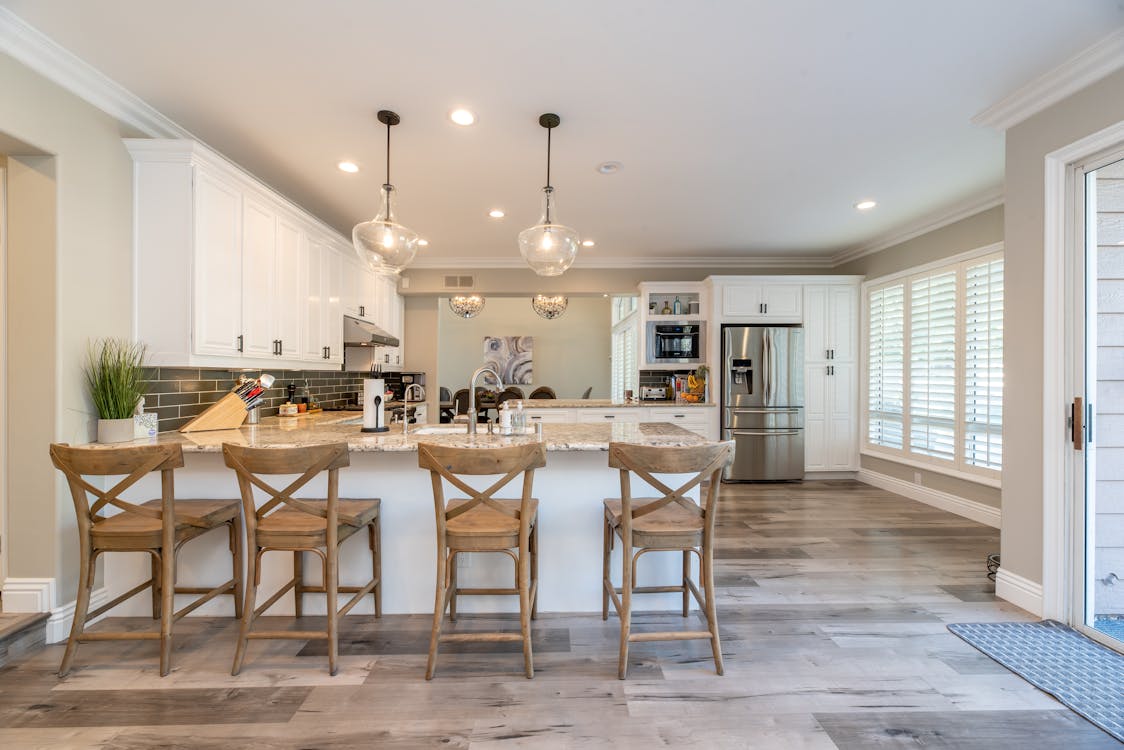
You’re almost there! The completion of the kitchen renovation process is an exciting time. Soon, you’ll be able to enjoy your newly transformed kitchen. But before you can fully revel in the results, there are a few important steps to take to ensure a smooth and successful conclusion to your project.
Managing the Construction Timeline
As the renovations near completion, it’s essential to manage the construction timeline effectively. Here are some tips to keep the process on track:
- Communicate with your contractor regularly to stay informed of progress and any potential delays.
- Be proactive in addressing any issues or concerns that arise during the final stages of the project.
- Plan ahead for inspections and permits that may be required before finalizing the renovations.
Quality Assurance and Inspections
Before you can officially declare your kitchen renovations complete, it’s crucial to conduct thorough quality assurance and inspections. This step ensures that everything has been done to your satisfaction and meets building codes and safety standards. Consider the following:
- Double-check that all electrical and plumbing work has been completed correctly and safely.
- Inspect the finishes, such as paint, flooring, and cabinetry, for any imperfections or damage.
- Test all appliances, fixtures, and technology systems to ensure they are functioning correctly.
Dealing with Unexpected Challenges
During any renovation project, it’s not uncommon to encounter unexpected challenges along the way. As you near the completion of your kitchen renovation, be prepared to address any last-minute surprises. Here’s how you can handle them:
- Stay flexible and open to alternative solutions if unforeseen issues arise.
- Maintain good communication with your contractor and other professionals involved in the project.
- Trust in the expertise of your hired professionals to find creative solutions to any obstacles that may come up.
By taking these steps to manage the construction timeline, conduct quality assurance and inspections, and address unexpected challenges, you’ll be well on your way to completing your kitchen renovation successfully.
Congratulations on making it this far! Your dream kitchen renovation is just around the corner. Soon, you’ll be able to gather with family and friends in a beautiful and functional space that enhances your daily life. Enjoy the fruits of your labor and savor the satisfaction of a well-executed renovation project.
Remember, if you ever need any further advice or inspiration for future projects, you can always refer back to this ultimate guide. Happy renovating!
Also read; Budget-Friendly Kitchen Renovations for Homeowners in 2023
Conclusion
Congratulations! You’ve reached the end of our ultimate guide to kitchen renovations. We hope this article has provided you with valuable insights, tips, and ideas to help you transform your kitchen into a space you’ll love.
Remember, a kitchen renovation is a significant investment, both in terms of time and money. By carefully assessing your needs, setting a realistic budget, and hiring the right professionals, you can ensure a successful renovation process from start to finish.
Designing your dream kitchen involves considering the layout, selecting high-quality materials, and choosing functional and stylish fixtures. Don’t forget the importance of maximizing storage and organization, selecting appliances and technology, and creating adequate lighting and ventilation.
Adding style and personality to your kitchen is another essential aspect of the renovation process. Whether you prefer a timeless design or want to incorporate trendy elements, selecting colors, patterns, and personalized decor and accessories can help you create a space that reflects your unique style.
Safety and functionality should also be a top priority. Installing reliable fire and carbon monoxide detectors, choosing durable and easy-to-clean surfaces, and ensuring proper venting and fire safety measures are crucial.
As you embark on your kitchen renovation journey, remember that unexpected challenges may arise. Managing the construction timeline, conducting quality assurance inspections, and staying flexible will help you navigate through any obstacles.
If you found this guide helpful and are looking for more inspiration and ideas, be sure to visit Arkitecture Today. Our blog provides a daily dose of architecture, home and interior design, decoration ideas, and more. Happy renovating!
Stay tuned! Click here to explore more about kitchen and home design on Arkitecture Today!
Frequently Asked Questions
- How much does a kitchen renovation typically cost?
The cost of a kitchen renovation can vary widely depending on factors such as the size of the kitchen, the quality of materials used, the extent of the renovation, and the location. On average, homeowners spend between $10,000 to $50,000 for a kitchen renovation.
- How long does a kitchen renovation project take to complete?
The duration of a kitchen renovation project depends on the complexity of the renovation and the scope of work involved. On average, a kitchen renovation can take anywhere from a few weeks to a few months to complete.
- What are some popular kitchen design ideas?
Some popular kitchen design ideas include open concept kitchens, farmhouse style kitchens, minimalist kitchens, and transitional kitchens. It’s important to choose a design that suits your personal style and complements the overall aesthetic of your home.
- Should I hire a professional contractor for my kitchen renovation?
While it’s possible to DIY a kitchen renovation, hiring a professional contractor is highly recommended. A professional contractor brings expertise, industry knowledge, and experience to the project. They can ensure the renovation is done properly, meet building codes, and offer valuable advice and guidance.
- What are some essential considerations for a successful kitchen renovation?
Some essential considerations for a successful kitchen renovation include setting a realistic budget, creating a functional layout, selecting high-quality materials, ensuring proper lighting and ventilation, and hiring reliable and skilled professionals for the project.


